5. F For Fake (1974)
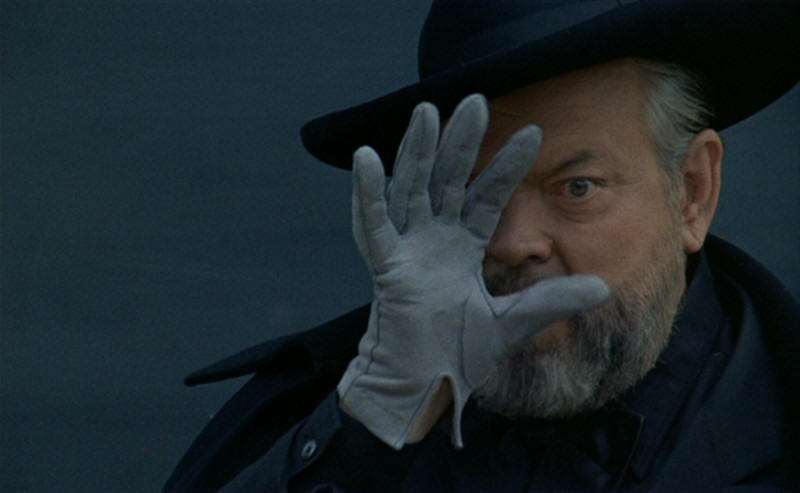
Orson Welles’ F For Fake from 1974 is not only one of the first examples of a modern mockumentary, but it also highlights philosophical aspects that are highly embedded within the nature of Derrida’s work.
The film presents itself as a meditation on fakery, illusion and narrative creation, by documenting certain famous ‘fakes’ Orson Welles places the audience at ease with the notion of the film being purely documentarian, however Welles reveals later that even the documentary aspect of the film was itself faked and that he had been sneakily hinting at subtextual clues throughout the entirety of the film.
In this way, Welles somewhat subverts Derrida’s notion that for a text to be a text it must hide its rules, but by revealing how texts, information and reality can manipulate our internal perceptions of these things, Welles instructs the audience in being more clever analyzers not only of film or stories, but also of language, identity, consciousness and perhaps even more conscious of these linguistic or ontological processes that form the narrative of our own being.
4. Cache (2005)
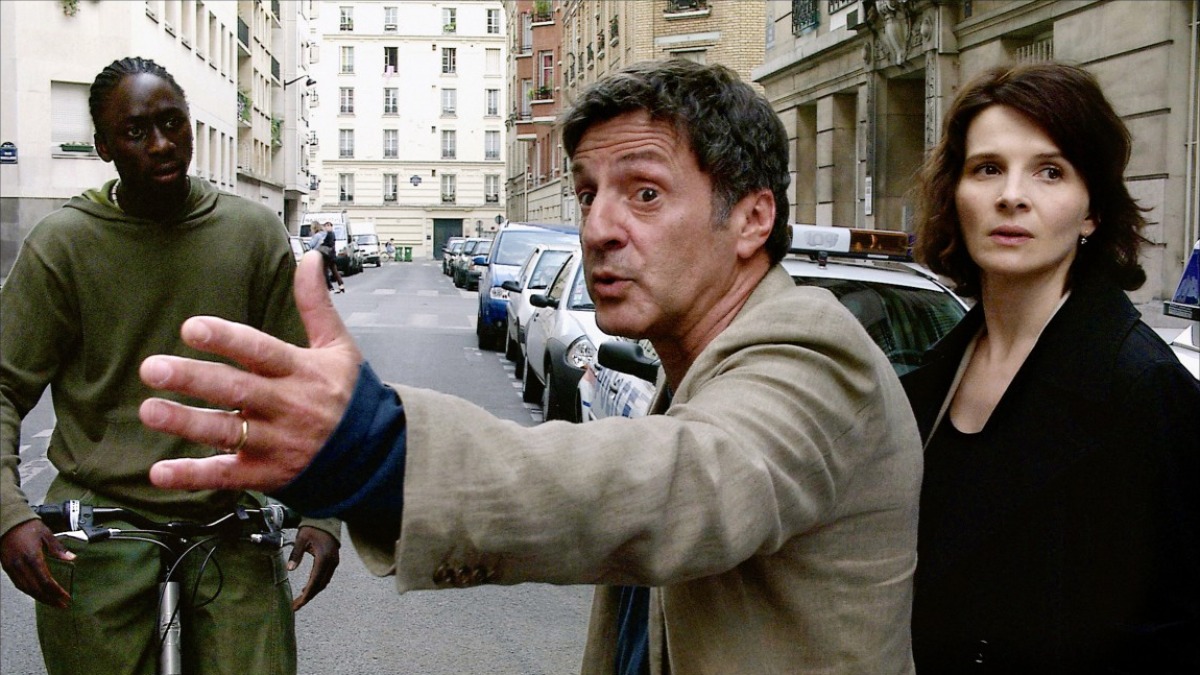
Michael Haneke’s Cache from 2005 is odd in that it deconstructs the concept of a modern thriller. Again, by shying away from traditional cinematography by using a sort of “fly-on-the-wall” style of filming and a less stylized sense of direction (somewhat similar to Hitchcock in the 50s), Haneke is able to formulate a sort of dissonant narratological spectrum of feelings and evocations that are more akin to Derridean post-structuralism than they are to something that is more in line with Andre Bazin’s analysis of early Hitchcock (for instance, he speaks of Hitchcock’s “stylistic repertory […] ranged from the power inherent in the basic document as such, to superimpositions, to large close-ups.”.
By infusing the narrative with a less formalistic style and focusing on the evocation of filmic grammar (rather than an exposition of it), Haneke was again able to create a text that “is a text”, by hiding the rules of the film’s world in the margins of the art.
By purposefully allowing room for rumination and abstraction on the part of the audience (as Hitchcock does in Rear Window), Haneke is able to create an invitation into introspection, rather than spectacle, which is something that Derrida advocated (although, in 2002 Derrida did worry about the increasing exploitation of spectacle in stating: “everything I say about the media, technology, the spectacle, and the ‘criticism of the show’, so to speak, and the markets – the becoming-a-spectacle of everything, and the exploitation of the spectacle.”).
By creating a cerebral atmosphere (though not an inherently pretentious or overtly intellectual situation) rather than an atmosphere of Spectacle, Haneke is able to evoke more complex emotions out of his audience, which is somewhat of an invocation of post-structuralist aesthetic.
3. Holy Motors (2012)
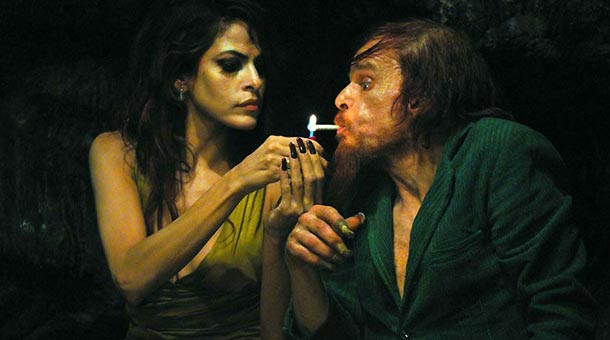
Leos Carax’s Holy Motors is a film that crosses multiple philosophies and nuances, but within its text it represents a great many ideas that Derrida discusses throughout his works.
Carax’s analysis of the malleability of identity and the use of identity across contexts is evident in Derrida’s understanding of identity not as a ‘capsule’ of selfhood (that is to say that the self exists outside of context or outside of a social grammar), but rather that the self is molded by external processes and the relations people have between each other. Derrida wrote in The Gift of Death that:
“The question of the self: who am I not in the sense of who am I but rather who is this I that can say who? What is the- I and what becomes of responsibility once the identity of the I trembles in secret?”
In this sense, Derrida is relating that the self or the “who” of oneself is defined in the expression of the “I” in relation to the “I”’s external experiences. Carax tackles this by portraying the main character Mr. Oscar (played by Denis Lavant) as a sort of pseudo-actor who takes upon different roles based upon the context in which he is placed.
In doing this, Carax allows us to experience the multifaceted existence of Mr. Oscar and subsequently allows Oscar to experience himself by relating to our relation to him (or perhaps his fellow actors’ relation to him). Essentially, in doing this Carax is acknowledging Derrida’s insight that:
“We are given over to absolute solitude. No one can speak with us and no one can speak for us; we must take it upon ourselves, each of us must take it upon himself.”
However, Carax also acknowledges that in self-reflection and our integration with our external experience, we are able to formulate a sense of unity of self, but ultimately cannot understand “the other” without the ability to express the deepest of our truths (perhaps best exemplified by the end of the film where the limousines begin speaking to each other and sharing their fears and dreams).
2. Beyond the Black Rainbow (2010)
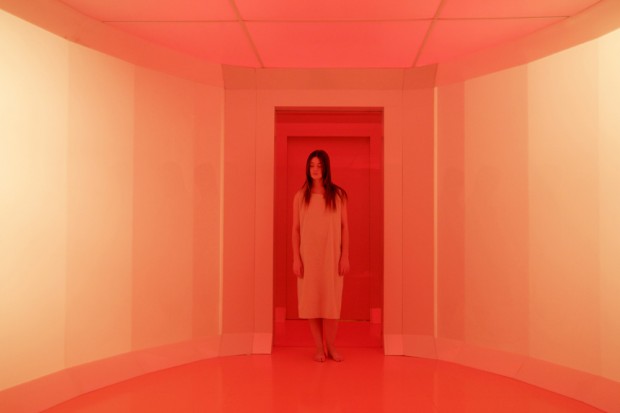
Panos Cosmatos’ Beyond the Black Rainbow is a depiction of unfiltered narrative, which is encoded in enigmatic reference to an overarching story, but becomes confusing when taken into context as its own story. By dropping the audience within the world of the film in media res, and without a clear ontological cinematic grammar to help the audience in decoding the nature of the world, Cosmatos forces the audience to rely solely on the imagery of the film in order to discover its meaning.
In a sense, Cosmatos could be said to be “painting on film” rather than simply relating a concise narrative to an audience. This sort of story-telling is favoured by Derrida, who stated:
“The poet…is the man of metaphor: while the philosopher is interested only in the truth of meaning, beyond even signs and names, and the sophist manipulates empty signs…the poet plays on the multiplicity of signifieds.”
In this sense by using imagistic metaphor (Cosmatos uses symbols of Christianity, neo-paganism and imagery of a new-age cult influence), he is able to relate to us the nature of his narrative thematically, though not quite specifically or concretely. By utilising generality as a narrative tool, Cosmatos films becomes less about the specific narrative and more about how the narrative, as a text is able to interact with us as individuals.
In this way, by making the text “living” in a way, he brings more providence to the film, allowing it to speak directly to the audience, rather than a screenwriter or author speaking to an audience through the lens of a cinematic narrative.
1. Jeanne Dielman, 23 quai du Commerce, 1080 Bruxelles (1975)
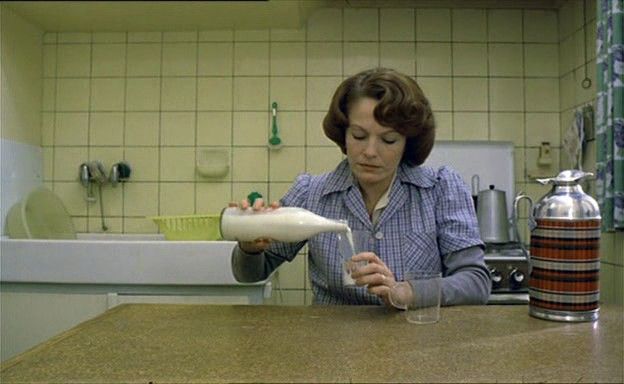
Akerman’s Jeanne Dielman is in a sense similar in narratological construction to Cosmatos’ Beyond the Black Rainbow, where they embody Derrida’s understanding of poetic treatment of art as a “play on the multiplicity of signifieds”. Where Cosmatos concerns himself with more arcane symbols of religious or psychological influence, Akerman focuses on the deconstruction of urbanity (much in the same way that Hitchcock focused on the deconstruction of urban America).
This doesn’t make any of her revelations any less arcane than Cosmatos, but perhaps even more so, in that through the deconstruction of modern femininity in the context of French urban life, she is able to relate to us an empathic vision or interpretation of Jeanne’s (played by Delphine Seyrig) life.
Again, by eschewing formalism, she helps us understand that through the deconstruction of pre-existing modalities we are able to dig at the deeper truth of our experience, through having the audience empathize with Jeanne, we are able to formulate an expression of understanding of her and subsequently a further understanding of ourselves in relation to the way we are able to empathize with other people.
The power of Derrida’s with respect to understanding the way texts can influence and move us is that by allowing ourselves more room for abstraction, we are more able to clearly realize the way external experience has upon the way we relate to ourselves and other human beings.
Author Bio: Alan is a writer, musician and composer from Calgary, Canada. His short fiction has been previously published in L’Allure des Mots out of Miami FL. His music can be found on Spotify and iTunes.